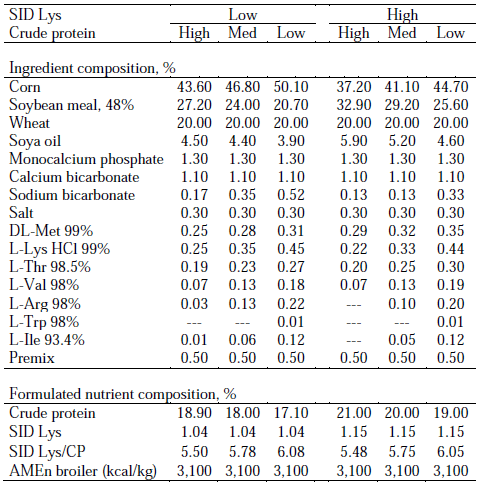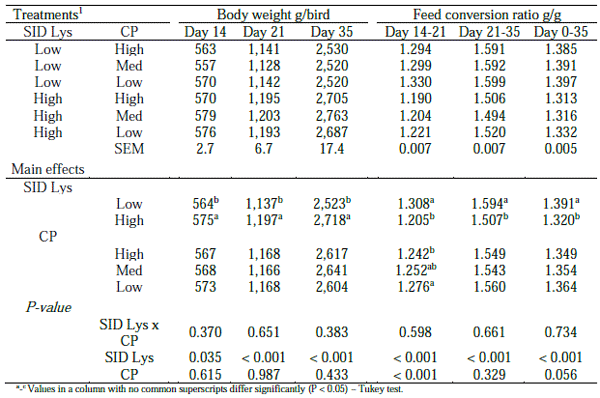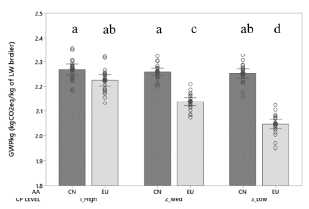I. INTRODUCTION
The nutritional strategy of reducing dietary crude protein (CP) in broiler diets to improve the sustainability of poultry production has been widely reviewed in the recent years (Hilliar and Swick, 2019; Selle et al., 2020). This strategy has proven benefits on global warming potential (GWP; Kebreab et al., 2016; Cappelaere et al., 2021) and litter quality (van Harn et al., 2018). In terms of growth performance, there is still a controversy on the ability of reduced-protein diets to maintain similar performance levels (Belloir et al., 2017; Chrystal et al., 2020; Maynard et al., 2021). To our knowledge, there has been no study so far on the influence of reducing dietary CP in broilers on GWP with two levels of dietary SID Lys and different origins of AA production. The objective of the present experiment was therefore to investigate the influence of dietary CP, AA density (SID Lys) and their interaction on global warming potential with two scenarios of AA origin.
II. METHOD
The six experimental treatments consisted in a 3 x 2 factorial design with 3 levels of dietary CP (High, Medium = -1%pt CP, Low = -2%pts CP) x 2 levels of dietary SID Lys (High, Low) with 0-35d male Ross 308 broilers (the grower diet composition is given as an example in Table 1). The reduction of dietary CP was applied by partially replacing SBM by cereals and feed-grade AA. The low SID Lys levels were formulated to match 90% of the Aviagen recommendations. Average daily gain, average daily feed intake and feed conversion ratio were monitored. Global warming potential was calculated kg of live weight broiler (GWPkg, kgCO2eq/kg of live weight (LW) broiler). GWP of the feeds was based on GFLI (Blonk consultants, 2019), except for the micro-ingredients (EcoAlim; Wilfart et al., 2016) and AA METEX NOOVISTAGO database, following FAO (2020) guidelines; available in Agribalyse (2022) V3.1). As GWP values of AA differ a lot between the countries of production, it was chosen to implement 2 scenarios: 1) AA are produced in Europe Union (EU) or 2) AA are produced in China (CN). The main difference between the two countries of production come from the raw material mix to produce feed-grade L-AA: EU = sugar beet, CN = glucose from corn. All data were submitted to a 2-way ANOVA statistical analysis. In addition, a 3-way ANOVA was performed for GWP with dietary SID Lys, dietary CP and AA sourcing strategy as main effects and their interactions. Significance was considered at P < 0.05. Statistical analysis was conducted using Minitab, version 21.
Table 1 - Ingredient and nutrient composition of the six experimental grower diets fed from 10 to 21d (grower feed) to broiler chickens.
III. RESULTS
Broilers outperformed the Aviagen (2018) performance objectives for Ross 308 male broilers by 385g of BW and by -11pts for FCR. No interaction between SID Lys and dietary CP was observed for any of the performance parameters (P > 0.05). Increasing dietary SID Lys significantly increased BW, ADG and reduced FCR from 0 to 14d, 14 to 21d, 21 to 35d and 0 to 35d (P < 0.05; Table 2). On the other hand, reducing dietary CP did not impact performance (P > 0.05) except for FCR before 21d. The reduction of dietary CP reduced GWPkg with both AA origin but the extent of reduction was much greater with EU AA as compared to CN AA (Figure 1). For instance, reducing dietary CP from High to Low dietary CP reduced GWPkg by 2.9% when using CN AA, and reduced GWPkg by 12% when using EU AA. In addition, switching the AA origin from CN to EU production reduced GWPkg by 2.4% in the High dietary CP treatments and reduced it by 10% in the Low dietary CP treatments.
Table 2 - Growth performance of broilers fed experimental diets differing in dietary CP and dietary SID lysine (10 replicates of 17 broilers per pen).
Figure 1 - Global warming potential of broilers in g CO2eq per kg of live weight broiler fed diets differing in dietary CP and AA sourcing strategy from 0 to 35d of age.
IV. DISCUSSION
The novelty of the study was to test dietary CP and SID Lys nutritional strategies in a factorial design. In this study, intermediate levels of SID Lys/CP were tested compared to recent publications (Van Harn et al., 2018, Chrystal et al., 2020; Maynard et al., 2021). There was no interaction between the two strategies, meaning that the reduction of dietary CP is achievable whatever if broilers are fed a low or a high level of AA density. Therefore, based on this experiment, the achievable level of dietary CP in practice could be as low as 17% in grower and 15.3% in finisher diets when formulating with dietary SID Lys at 90% of Aviagen (2018) recommendations. The effect of reducing dietary CP on GWP of broiler has already been evaluated by Mosnier et al. (2011), Kebreab et al. (2016) and reviewed by Cappelaere et al. (2021). For example, Mosnier et al. (2011) evaluated that the reduction of dietary CP reduced GWP by 5.3% compared to control, but this result was dependent on regions of production of SBM and corn. The novelty of the present study is that 1) the latest published GWP databases (Wilfart et al., 2016; GFLI, 2019) were used to study the impacts of the nutritional interventions, 2) 2 scenarios of AA sourcing strategy were compared, and 3) basic nutritional strategies such as increased SID Lys or reduced dietary CP were tested. However, regarding the methodology of the study, it was not possible to integrate the farm characteristics and the manure management strategy in this study like in Mosnier et al. (2011).
Presented at the 34th Annual Australian Poultry Science Symposium 2023. For information on the next edition, click here. 













.jpg&w=3840&q=75)